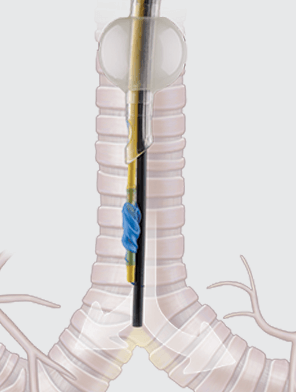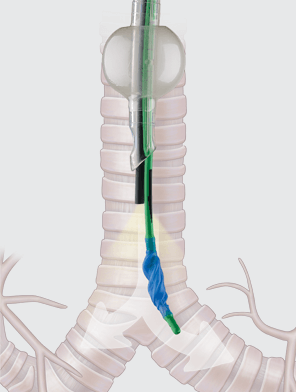Our endobronchial blockers allow one-lung ventilation through a conventional single-lumen endotracheal tube that is easier to place and poses a lower risk of trauma to internal structures than a double-lumen tube.1 View each product’s indications for use, specifications, components, and other resources by clicking the links below.
Arndt Endobronchial Blocker
 Intended to differentially intubate a patient’s bronchus in order to isolate the left or right lung for procedures that require one-lung ventilation. The product is intended for use by physicians trained and experienced in the use of fibreoptic bronchoscopes and airway anatomy. Standard techniques for use of fibreoptic bronchoscopes and endobronchial blockers should be employed.
Intended to differentially intubate a patient’s bronchus in order to isolate the left or right lung for procedures that require one-lung ventilation. The product is intended for use by physicians trained and experienced in the use of fibreoptic bronchoscopes and airway anatomy. Standard techniques for use of fibreoptic bronchoscopes and endobronchial blockers should be employed.
Features and benefits
• The low-pressure, high-volume balloon creates excellent surface area contact with the inner bronchial wall while minimising potential trauma to the bronchus.
• The adjustable guide loop is coupled with an appropriately sized bronchoscope to enable precise placement.
View more details about the Arndt Endobronchial Blocker.
Cohen Endobronchial Blocker
 Intended for use to differentially intubate a patient’s bronchus in order to isolate the left or right lung for procedures that require one-lung ventilation. The product is intended for use by physicians trained and experienced in one-lung ventilation. Standard techniques for placement of endobronchial blockers should be employed.
Intended for use to differentially intubate a patient’s bronchus in order to isolate the left or right lung for procedures that require one-lung ventilation. The product is intended for use by physicians trained and experienced in one-lung ventilation. Standard techniques for placement of endobronchial blockers should be employed.
Features and benefits
• The unique deflecting tip provides a wide range of motion to precisely direct the blocker under bronchoscopic guidance.
• The high-traction silicone grip on the introducer shaft increases the operator’s control, resulting in precise device placement.
View more details about the Cohen Endobronchial Blocker.
Citations
- Knoll H, Ziegeler S, Schreiber JU, et al. Airway injuries after one-lung ventilation: a comparison between double-lumen tube and endobronchial blocker: a randomized, prospective, controlled trial. Anesthesiology. 2006;105(3):471-477.